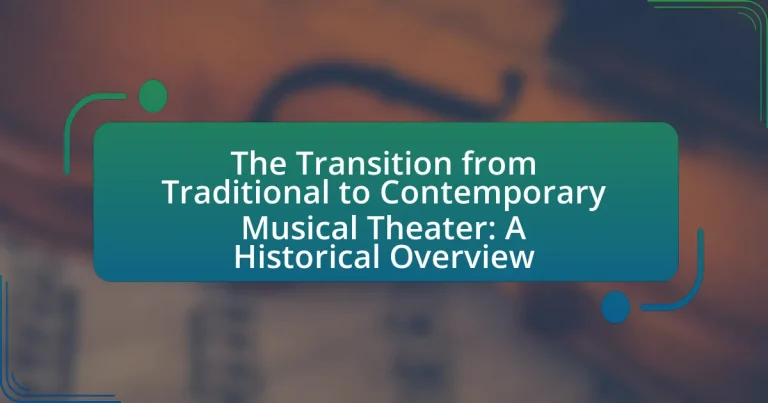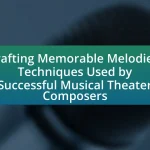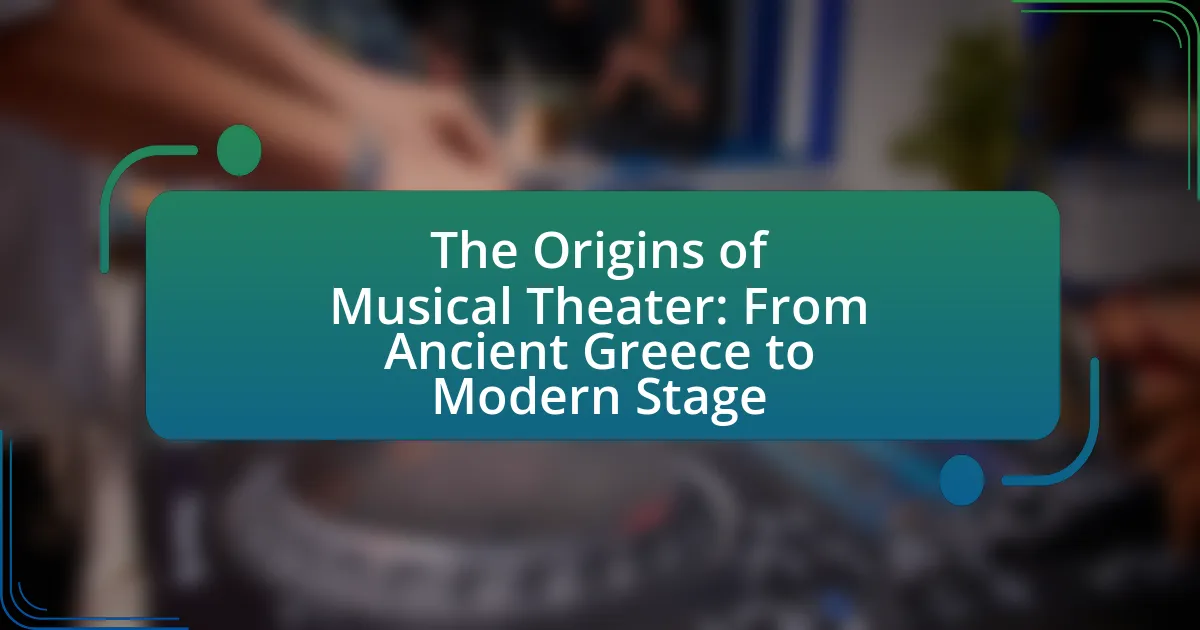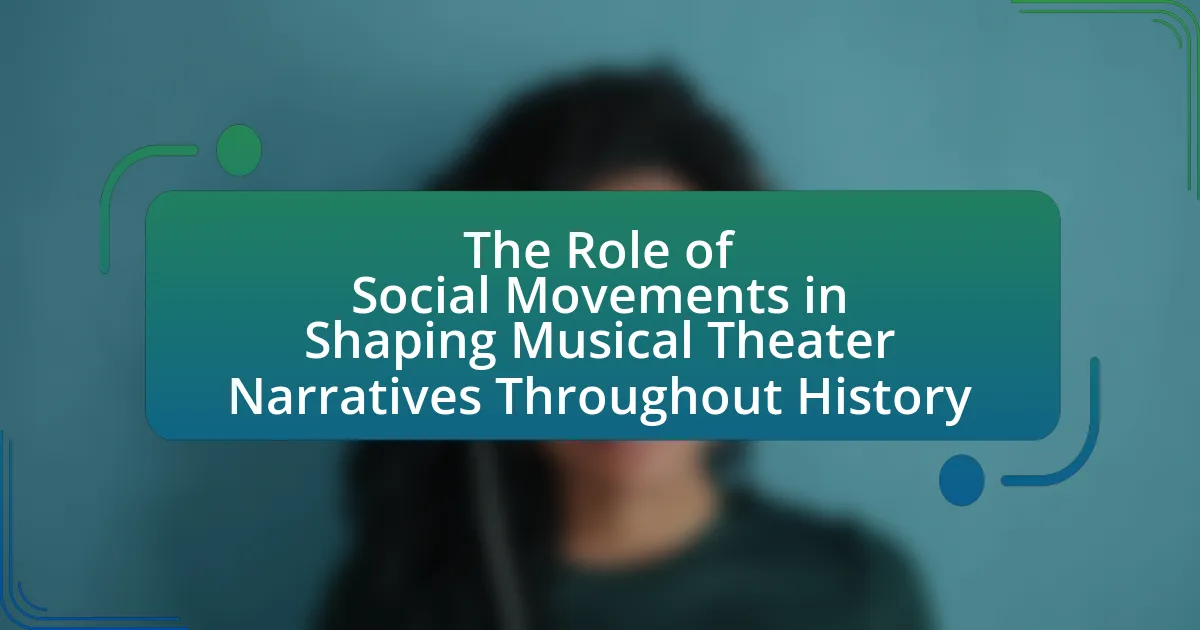The article examines the transition from traditional to contemporary musical theater, highlighting the significant shifts in themes, styles, and production techniques that reflect societal changes and artistic innovations. It outlines the evolution of traditional musical theater from its roots in operetta and vaudeville to the emergence of complex narratives and diverse themes in contemporary works. Key characteristics of both traditional and contemporary musical theater are discussed, along with the impact of cultural movements, technological advancements, and influential figures on this evolution. The article emphasizes the importance of this transition in making musical theater more relevant and engaging for modern audiences.

What is the Transition from Traditional to Contemporary Musical Theater?
The transition from traditional to contemporary musical theater involves a shift in themes, styles, and production techniques that reflect societal changes and artistic innovations. Traditional musical theater, characterized by its structured plots and musical numbers, often focused on romantic and comedic narratives, while contemporary musical theater embraces diverse themes, including social issues and personal identity, often incorporating elements from various musical genres such as rock, hip-hop, and pop. This evolution is evidenced by landmark productions like “Rent” in the 1990s, which addressed topics like HIV/AIDS and LGBTQ+ rights, contrasting with earlier works like “Oklahoma!” that adhered to more conventional storytelling. The integration of technology, such as advanced lighting and sound design, further distinguishes contemporary productions, enhancing audience engagement and storytelling.
How did traditional musical theater evolve over time?
Traditional musical theater evolved over time through a series of significant transformations influenced by cultural, social, and technological changes. Initially rooted in operetta and vaudeville in the 19th century, traditional musical theater incorporated elements of storytelling, music, and dance, exemplified by works like Gilbert and Sullivan’s “The Mikado.” The early 20th century saw the emergence of the American musical, with composers like George Gershwin and Rodgers and Hammerstein introducing more complex narratives and character development, as seen in “Oklahoma!” (1943).
The mid-20th century brought further evolution with the integration of rock music and diverse themes, leading to groundbreaking productions such as “Hair” (1967) and “A Chorus Line” (1975), which reflected contemporary societal issues. By the late 20th and early 21st centuries, traditional musical theater began to incorporate multimedia elements and innovative staging techniques, as demonstrated in shows like “The Lion King” (1997) and “Hamilton” (2015), blending traditional forms with modern storytelling and technology. This evolution illustrates how traditional musical theater has continuously adapted to reflect changing artistic expressions and audience expectations.
What are the defining characteristics of traditional musical theater?
Traditional musical theater is characterized by a combination of song, dance, and dialogue to tell a story, often featuring a clear narrative structure. This genre typically includes distinct musical numbers that advance the plot or develop characters, with a strong emphasis on spectacle and performance. Historically, traditional musical theater has roots in operetta and vaudeville, showcasing elaborate costumes and sets, and often incorporates themes of romance, comedy, and social issues. The integration of music and lyrics, as exemplified by works from composers like Rodgers and Hammerstein, reinforces emotional connections and enhances storytelling, making it a unique and enduring form of entertainment.
What historical events influenced the development of traditional musical theater?
The development of traditional musical theater was significantly influenced by the emergence of operetta in the 19th century, which combined spoken dialogue with musical numbers. This genre, popularized by composers like Gilbert and Sullivan, laid the groundwork for the integration of music and narrative in theater. Additionally, the rise of vaudeville in the United States during the late 19th and early 20th centuries introduced a variety of performance styles, including comedy, dance, and music, which further shaped the musical theater format. The Broadway musical, as it is known today, began to take form in the early 20th century, particularly with the success of shows like “Show Boat” in 1927, which incorporated serious themes and complex characters, marking a shift towards more sophisticated storytelling in musical theater. These historical events collectively contributed to the evolution of traditional musical theater into a distinct and influential art form.
What are the key features of contemporary musical theater?
Contemporary musical theater is characterized by its integration of diverse musical styles, innovative storytelling techniques, and a focus on complex characters and themes. This genre often blends elements from pop, rock, hip-hop, and other musical genres, reflecting current cultural trends and appealing to a broader audience. Additionally, contemporary works frequently employ non-linear narratives and multimedia elements, enhancing the theatrical experience. For instance, productions like “Hamilton” utilize hip-hop to convey historical narratives, while “Dear Evan Hansen” addresses modern social issues such as mental health and identity. These features demonstrate the evolution of musical theater into a more inclusive and relevant art form, resonating with contemporary audiences.
How does contemporary musical theater differ from traditional forms?
Contemporary musical theater differs from traditional forms primarily in its thematic complexity and stylistic diversity. While traditional musical theater often focuses on clear narratives and familiar genres, contemporary works frequently explore complex social issues, diverse cultural perspectives, and innovative musical styles, reflecting a broader range of human experiences. For instance, shows like “Hamilton” integrate hip-hop and R&B to tell historical narratives, while “Dear Evan Hansen” addresses mental health and social media, showcasing a shift towards more relevant and relatable themes for modern audiences. This evolution highlights the genre’s adaptability and responsiveness to societal changes, marking a significant departure from the conventions of earlier musical theater.
What themes and styles are prevalent in contemporary musical theater?
Contemporary musical theater prominently features themes of identity, social justice, and personal struggle, reflecting modern societal issues. Styles in this genre often blend traditional musical elements with diverse influences such as pop, rock, and hip-hop, creating a more eclectic sound. Notable examples include “Hamilton,” which addresses race and history through a hip-hop lens, and “Dear Evan Hansen,” which explores mental health and connection in the digital age. These themes and styles demonstrate a shift towards more relatable and relevant narratives, engaging audiences with contemporary issues.
Why is the transition from traditional to contemporary musical theater significant?
The transition from traditional to contemporary musical theater is significant because it reflects evolving societal values and artistic expressions. Traditional musical theater often adhered to established narratives and structures, while contemporary musical theater embraces diverse themes, innovative storytelling techniques, and a broader range of musical styles. This shift has led to the inclusion of more complex characters and narratives that resonate with modern audiences, as seen in productions like “Hamilton,” which integrates hip-hop and addresses historical and social issues. The significance lies in its ability to engage with current cultural conversations, making the art form more relevant and accessible to a wider audience.
What impact has this transition had on audiences and performers?
The transition from traditional to contemporary musical theater has significantly impacted both audiences and performers by broadening the scope of storytelling and enhancing engagement. Audiences now experience more diverse narratives that reflect contemporary social issues, leading to increased emotional resonance and relatability. For instance, shows like “Hamilton” have introduced historical figures in a modern context, attracting a wider demographic and fostering discussions around race and identity.
Performers benefit from this transition as well, gaining opportunities to showcase a wider range of talents, including contemporary dance styles and varied vocal techniques. The rise of new musical genres and innovative staging has allowed performers to explore their artistry in ways that traditional formats did not permit. This evolution has led to a more dynamic and inclusive theater environment, where both audiences and performers can engage with the art form on multiple levels.
How has the industry responded to the changes in musical theater?
The industry has responded to the changes in musical theater by embracing diverse storytelling, innovative production techniques, and a broader range of musical styles. This shift is evident in the rise of contemporary works that incorporate elements from various genres, such as hip-hop in “Hamilton,” which has garnered critical acclaim and commercial success, demonstrating the industry’s adaptability to evolving audience preferences. Additionally, the integration of technology in productions, such as advanced lighting and sound design, has enhanced the theatrical experience, reflecting a commitment to modernizing the art form while maintaining its core essence.
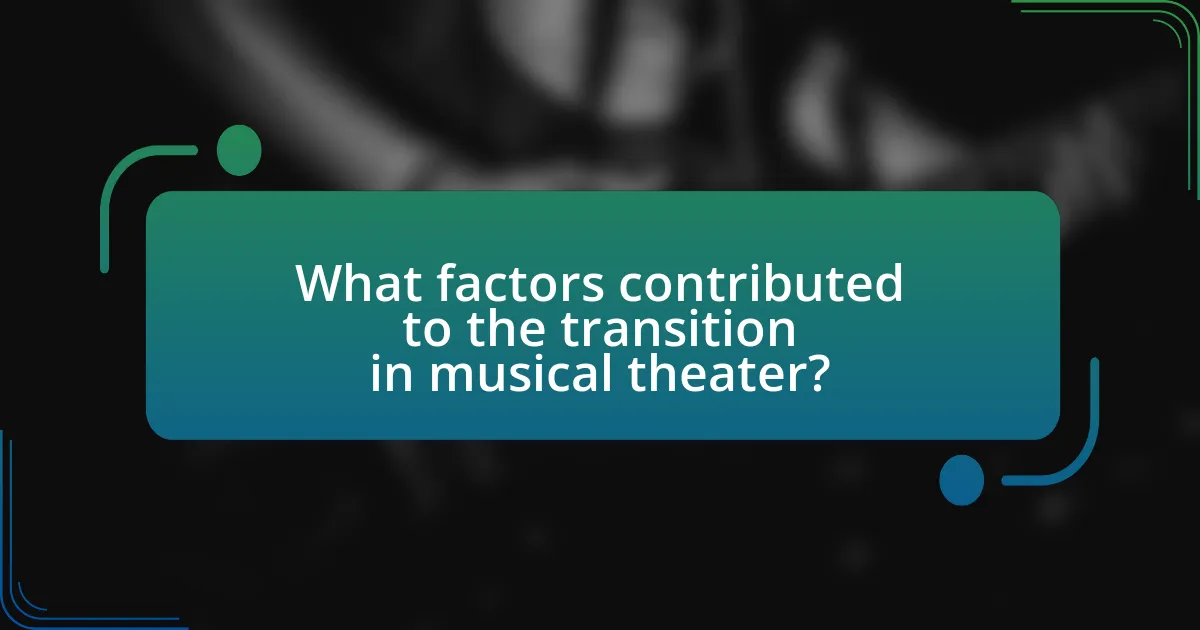
What factors contributed to the transition in musical theater?
The transition in musical theater was primarily influenced by changes in societal norms, advancements in technology, and shifts in artistic expression. Societal norms evolved post-World War II, leading to more diverse themes and characters being explored on stage, reflecting contemporary issues such as race, gender, and sexuality. Technological advancements, particularly in sound and lighting, allowed for more elaborate productions and enhanced storytelling. Additionally, the rise of rock and pop music genres in the 1960s and 1970s introduced new musical styles to the theater, exemplified by shows like “Hair” and “Rent,” which broke traditional molds and appealed to younger audiences. These factors collectively reshaped the landscape of musical theater, moving it towards a more modern and inclusive form.
How did societal changes influence musical theater?
Societal changes significantly influenced musical theater by shaping its themes, styles, and audience engagement. For instance, the rise of the civil rights movement in the 1960s led to the incorporation of diverse narratives and characters, as seen in productions like “Hair,” which addressed social issues such as war and equality. Additionally, the feminist movement prompted musicals like “A Chorus Line,” which explored women’s experiences and aspirations, reflecting changing gender roles. Economic shifts, such as the Great Depression, also impacted musical theater, leading to more escapist themes in the 1930s, as exemplified by shows like “Anything Goes.” These societal transformations directly informed the evolution of musical theater, making it a mirror of contemporary cultural dynamics.
What role did cultural movements play in shaping contemporary musical theater?
Cultural movements have significantly influenced contemporary musical theater by introducing diverse themes, styles, and narratives that reflect societal changes. For instance, the civil rights movement in the 1960s led to the emergence of productions that addressed racial issues, such as “Hair,” which incorporated rock music and counterculture themes. Additionally, the feminist movement has inspired works like “Wicked,” which reinterprets traditional narratives through a feminist lens, showcasing strong female characters and challenging gender norms. These movements have not only expanded the scope of storytelling in musical theater but also encouraged inclusivity and representation, as seen in the rise of productions featuring LGBTQ+ narratives, such as “Rent.” Thus, cultural movements have been pivotal in shaping the evolution of contemporary musical theater, making it a more reflective and relevant art form.
How have technological advancements affected musical theater productions?
Technological advancements have significantly transformed musical theater productions by enhancing visual effects, sound quality, and overall audience engagement. Innovations such as digital projection, advanced lighting systems, and high-fidelity sound design have allowed productions to create immersive environments that were previously unattainable. For instance, the use of LED screens and projection mapping in shows like “Hamilton” and “The Lion King” has enabled dynamic backdrops that change in real-time, enriching storytelling. Additionally, sound technology improvements, such as wireless microphones and sophisticated mixing systems, have improved vocal clarity and audience experience, making performances more accessible and enjoyable. These advancements have not only elevated production quality but also expanded creative possibilities for directors and designers, leading to a new era in musical theater.
What role did influential figures play in this transition?
Influential figures played a crucial role in the transition from traditional to contemporary musical theater by introducing innovative storytelling techniques, diverse musical styles, and new thematic content. Pioneers such as Stephen Sondheim revolutionized the genre with complex lyrics and intricate melodies, as seen in works like “Sweeney Todd” and “Into the Woods,” which emphasized character development and narrative depth. Additionally, figures like Lin-Manuel Miranda brought hip-hop and multicultural influences to the forefront with “Hamilton,” reflecting contemporary societal issues and expanding the audience’s perception of musical theater. These contributions not only transformed the artistic landscape but also broadened the appeal of musical theater to a wider, more diverse audience.
Who are some key composers and playwrights in contemporary musical theater?
Key composers and playwrights in contemporary musical theater include Lin-Manuel Miranda, Stephen Schwartz, and Jason Robert Brown. Lin-Manuel Miranda is renowned for “Hamilton,” which revolutionized the genre with its blend of hip-hop and traditional musical elements. Stephen Schwartz is known for “Wicked,” which has become a modern classic since its debut in 2003, showcasing innovative storytelling and character development. Jason Robert Brown has made significant contributions with works like “The Last Five Years,” which employs a unique narrative structure and emotional depth. These artists exemplify the evolution of musical theater, pushing boundaries and redefining the form.
How did their works challenge traditional norms?
Their works challenged traditional norms by introducing innovative storytelling techniques and diverse musical styles that deviated from established conventions. For instance, contemporary musical theater often incorporates elements from various genres, such as rock, hip-hop, and jazz, which contrasts with the classical structures of earlier musicals. Additionally, shows like “Rent” and “Hamilton” address social issues and represent marginalized voices, breaking away from the romanticized narratives typical of traditional musicals. This shift not only reflects changing societal values but also expands the thematic scope of musical theater, making it more relevant to modern audiences.

What are the implications of the transition for future musical theater?
The transition from traditional to contemporary musical theater implies a significant evolution in storytelling, audience engagement, and production techniques. This shift allows for more diverse narratives and representation, reflecting societal changes and broadening the appeal to a wider audience. For instance, contemporary musicals often incorporate various musical styles and multimedia elements, enhancing the overall experience and attracting younger demographics. Additionally, the rise of digital platforms for distribution and promotion has transformed how productions reach audiences, making theater more accessible. This evolution is evidenced by successful contemporary works like “Hamilton,” which blends hip-hop with historical storytelling, demonstrating the potential for innovation in the genre.
How might contemporary musical theater continue to evolve?
Contemporary musical theater might continue to evolve by integrating diverse cultural influences and utilizing advanced technology in storytelling. The incorporation of various musical styles, such as hip-hop and electronic music, reflects the changing tastes of audiences and broadens the genre’s appeal. Additionally, the use of digital projections and interactive elements can enhance the theatrical experience, as seen in productions like “Dear Evan Hansen,” which employs social media themes to resonate with younger viewers. This evolution is supported by the increasing representation of underrepresented voices in writing and performance, leading to more inclusive narratives that reflect contemporary societal issues.
What emerging trends are shaping the future of musical theater?
Emerging trends shaping the future of musical theater include increased diversity in storytelling, the integration of technology, and a focus on social issues. The push for diverse narratives is evident as productions increasingly feature stories from underrepresented communities, reflecting a broader cultural shift towards inclusivity. The use of technology, such as augmented reality and digital projections, enhances the audience experience and allows for innovative staging techniques. Additionally, musical theater is increasingly addressing social issues, with works that tackle themes like mental health, climate change, and systemic inequality, resonating with contemporary audiences. These trends indicate a significant evolution in the genre, moving away from traditional narratives to more relevant and engaging content.
How can new artists contribute to the evolution of the genre?
New artists can contribute to the evolution of the genre by introducing innovative themes, diverse perspectives, and modern storytelling techniques. For instance, contemporary musical theater has seen a rise in narratives that reflect current social issues, such as race, gender, and mental health, which were less prevalent in traditional works. This shift is exemplified by productions like “Hamilton,” which reinterprets historical events through a contemporary lens and incorporates hip-hop music, thereby attracting a broader audience and redefining genre boundaries. Additionally, new artists often experiment with multimedia elements and technology, enhancing the overall theatrical experience and pushing creative limits. These contributions not only enrich the genre but also ensure its relevance in a rapidly changing cultural landscape.
What best practices can be adopted in contemporary musical theater?
Best practices in contemporary musical theater include embracing diverse storytelling, integrating technology effectively, and fostering collaboration among artists. Diverse storytelling allows for a broader range of perspectives and experiences, which can attract wider audiences and reflect societal changes. For instance, productions like “Hamilton” have successfully incorporated diverse narratives, leading to critical acclaim and commercial success.
Integrating technology, such as advanced lighting, sound design, and multimedia elements, enhances the audience experience and can elevate the storytelling. Productions like “Dear Evan Hansen” utilize social media and digital platforms to engage with audiences before and after performances, creating a more immersive experience.
Fostering collaboration among writers, directors, choreographers, and performers encourages innovation and creativity, resulting in fresh interpretations of musical theater. The collaborative approach seen in shows like “The Book of Mormon” demonstrates how teamwork can lead to groundbreaking work that resonates with contemporary audiences.
How can producers and directors effectively blend traditional and contemporary elements?
Producers and directors can effectively blend traditional and contemporary elements by integrating classic storytelling techniques with modern themes and innovative staging. This approach allows for the preservation of the essence of traditional musical theater while appealing to contemporary audiences. For instance, the use of updated musical arrangements and diverse casting can modernize a classic work, as seen in productions like “Hamilton,” which combines hip-hop with historical narratives. Additionally, incorporating technology, such as projections and digital sound design, enhances the visual and auditory experience, making traditional stories resonate with today’s viewers. This method not only honors the roots of musical theater but also ensures its relevance in a rapidly evolving cultural landscape.
What strategies can be employed to engage modern audiences?
To engage modern audiences, musical theater can employ strategies such as incorporating diverse storytelling, utilizing technology, and enhancing interactivity. Diverse storytelling reflects contemporary societal issues and multicultural perspectives, which resonate with a broader audience. For instance, productions like “Hamilton” have successfully attracted diverse demographics by blending historical narratives with modern music styles. Utilizing technology, such as augmented reality and social media engagement, enhances the audience experience and creates a more immersive environment. Additionally, interactive elements, such as audience participation or choose-your-own-adventure formats, foster a deeper connection between the performers and the audience, making the experience more memorable. These strategies are supported by trends indicating that audiences increasingly seek relatable content and innovative experiences in entertainment.
